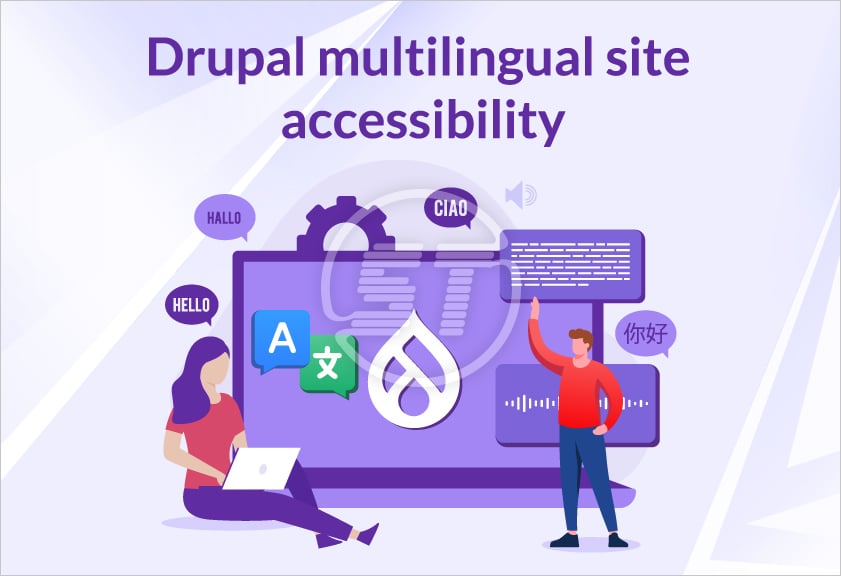Creating websites that are accessible to everyone is the basic requirement for every business now. With increasing awareness around inclusivity, organizations are prioritizing accessibility standards to ensure that their digital content is usable by all users trying to explore their websites/applications.
For Drupal site owners, the challenge grows even more complex when managing multilingual websites. Combining Web Content Accessibility Guidelines (WCAG) and Americans with Disabilities Act (ADA) compliance with multilingual content can seem daunting, but it is a vital step toward inclusivity.
In this article, we’ve curated content on how Drupal multilingual websites can ensure that their content is both language-diverse and accessible.
The intersection of accessibility and multilingual content!
Accessibility involves designing websites that can be used by everyone, including those with disabilities, while multilingual support focuses on providing content in different languages. Combining these two elements is vital for serving a global audience. It is important to remember that accessibility considerations extend to all languages a site offers, and each language version must meet the same WCAG and ADA requirements.
Outline to enhance accessibility in multilingual Drupal sites!
Choose an accessible base theme
Begin with a Drupal theme that is built with accessibility in mind. Themes like Olivero and Bartik follow WCAG guidelines, providing a solid foundation for accessible design. These themes support features like keyboard navigation, color contrast, and screen reader compatibility, which are essential for digital accessibility.
Implement multilingual modules
Drupal’s multilingual capabilities are powered by a suite of modules like Locale, Content Translation, Interface Translation, and Language. When configuring these modules, ensure that accessibility is preserved across all languages. For example, language-switching mechanisms should be intuitive and easily accessible via assistive technologies.
Ensure proper language attributes and markup
Assigning correct language attributes in the HTML code is crucial for screen readers. In Drupal multilingual sites, each page or content block should have specified language attributes (for example: ‘lang=”en”’ for English). Drupal’s multilingual modules handle much of this automatically, but it’s important to double-check that every piece of translated content includes the correct attributes.
Optimize for screen readers across languages
Screen readers interpret content differently depending on the language settings. Ensuring accurate pronunciation and reading order for translated content is a must. Test each language version using screen reader tools to identify and fix any accessibility issues.
Maintain consistent navigation and layout
Consistency across languages helps all users, particularly those relying on assistive technologies, to navigate the site effectively. Use a consistent layout, labelling, and structure across the multilingual site to avoid confusion and improve usability.
Accessible language switcher
The language switcher should be easy to find, accessible via keyboard, and labelled clearly for screen readers. Avoid using flags as indicators for languages, as they can be ambiguous and do not meet accessibility standards. Instead, use textual labels like “English” or “Espanol”.
Alt text and media description in alt languages
Ensure that all images, videos, and multimedia content include descriptive alt text and captions in each language. This practice not only enhances accessibility but also supports better SEO. Drupal’s Media and Image modules allow organizations to manage alt text for different language versions effectively.
Test for accessibility compliance regularly
Automated tools like Axe, WAVE, or SiteImprove can help test a Drupal website for WCAG compliance. However, manual testing is also essential, especially for multilingual content.
Simplify language and content structure
Writing in plain language and using simple, clear content structures benefit all users, including those with cognitive disabilities. Keep sentences concise and avoid jargon in each language version. Drupal’s content editing tools allow to maintain consistency in structure and style across different languages.
Leverage Drupal’s accessibility modules
Drupal offers several modules aimed at enhancing accessibility, such as the Drupal All in One Accessibility, automatic alternative text and automatic content modules. These modules provide tools for generating alt text, validating content against WCAG criteria, making it easier to manage accessibility across multiple languages. All in One Accessibility supports 140+ languages.
Drupal 11 – Inclusivity at its core!
Drupal 11 is one step ahead of its predecessor in terms of offering web accessibility. It includes myriad features to improve the website’s accessibility against WCAG and ADA standards.
Recipes API
This API makes it simple to replicate accessibility configuration across multiple sites and keep consistency between accessibility standards for websites.
Access policy APIs
It offers full control over access permissions for better content management, which enhances its accessibility.
Advanced auditing tools
Drupal 11 core is integrated with auditing tools to facilitate the implementation and verification of accessibility features.
And there is much more.
(For better multilingual accessibility results, upgrade or migrate to Drupal 11.)
In a nutshell,
Building an accessible multilingual website on Drupal requires careful planning and continuous efforts. By following WCAG and ADA guidelines and leveraging Drupal’s robust multilingual and accessibility tools, you can create a site that serves users of all abilities and languages.
Prioritizing both accessibility and language inclusivity ensures that the website’s digital presence is open to everyone, creating a truly universal user experience.
We are a Drupal Gold Certified Partner supporting and contributing to the Drupal Association and project. We go above and beyond to meet additional criteria of contribution back to the Drupal projects.
Our Drupal All in One Accessibility module supports 140+ languages enhancing a seamless experience for users globally. It is available with 70 plus features, and available in different plans based on the size and pageviews of the website. This interface allows users to select the accessibility features as per their needs and peruse the content.


